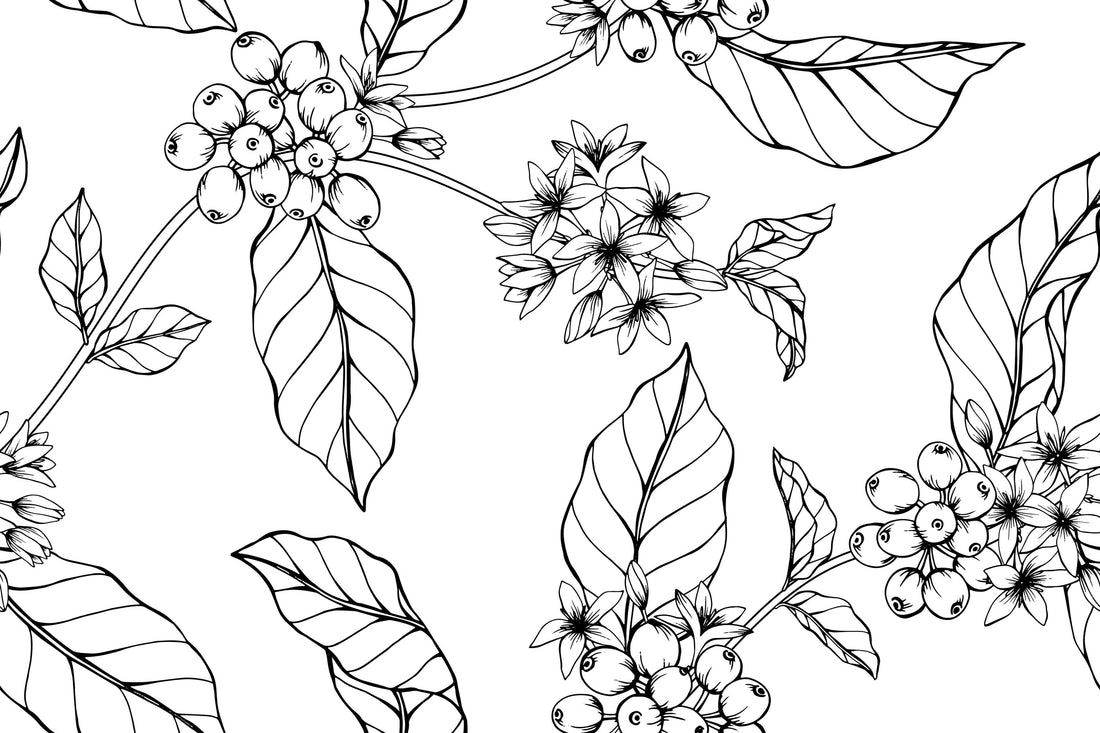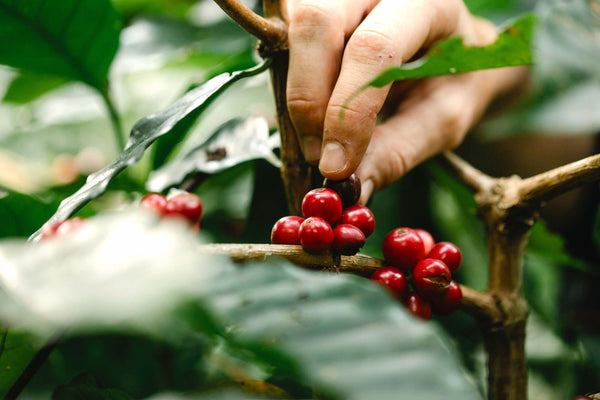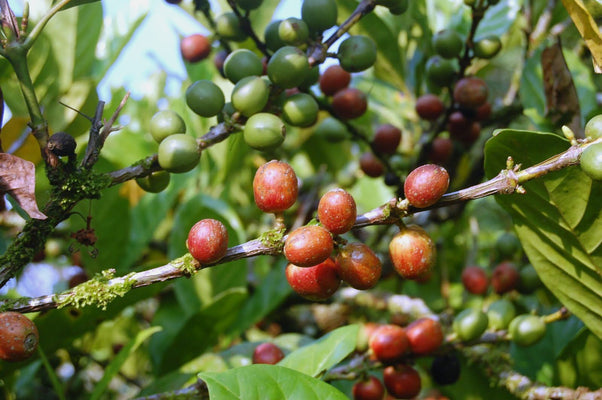
All About Coffea
tai attitude9 min read
Coffea is a flowering shrub or small tree (abbreviated as coffee plant) that originated on the African and Asian continents. Coffea produces edible fruit. Each fruit contains two green seeds, which turn brown after roasting and are known as coffee beans.
As of this writing, there are currently 124 identified Coffea species in the world, but only 2 of them, namely Coffea arabica and Coffea canephora (Robusta), are primarily cultivated worldwide in over 70 countries in the equatorial regions of the Americas, Africa, and Asia.
Today, Coffea arabica and Coffea canephora are traded and consumed worldwide; these two species constitute the general consensus about coffee. The other coffeas are much less known, either growing in the wild or being cultivated to a much smaller degree.
The Main 2 + 1
Coffea arabica, also known as Arabica, is a hybrid species from the hybridization of two species of Coffea eugenioides and Coffea canephora (Robusta). This natural hybridization event that birthed Coffea arabica is estimated to have happened between 1.08 million and 543,000 years ago.
Arabica coffee is well-known for its aromatic qualities and sweet taste. It accounts for 60–80% of world coffee production and is the most consumed coffea species today. In pursuing its quality, Arabica has the most selective breeding or natural selection, with countless different varieties and cultivars to choose from.
Coffea canephora goes by the nickname Robusta. Robusta is regarded as the stronger coffee; it is more bitter, has a harsher mouthfeel, and is much lower in aromatic qualities. Robusta is one of the two parents of Arabica.
It has a market share of 20–40% of world coffee production and is the second most consumed coffea species. Robusta's advantages are that it can be grown at lower elevations, is hardy to pests, has resistance to coffee leaf rust, and has a higher crop yield.
Read more about Arabica and Robusta.
Coffea liberica, also known as Liberica, is much larger in fruit, which tends to have a higher fermentation degree in its own post-harvest processing. Liberica coffee is best described as fermenty sweet, bold in mouthfeel, yet low in acidity. It tastes inherently different from Arabica or Robusta, like each species does.
Referred to as the third coffee species by some, Liberica is cultivated in some countries in much smaller quantities, with an estimated less than 2% market share. It is considered a scarce coffee and highly sought after by its enthusiasts, who appreciate its attributes.
Read more about Liberica.
The Next?
Coffea eugenoides is a coffea species native to the East and Central African countries of Burundi, Kenya, Rwanda, Sudan, South Sudan, Tanzania, Uganda, and the DR Congo.
Eugenoides is one of the two parents of Arabica. Most of Arabica's aromatic and fruity traits are believed to be inherited from Eugenoides.
Eugenoides has only about half the caffeine content of Arabica, thereby a quarter that of Robusta. Since caffeine itself is bitter tasting, eugenoides coffee is very low in perceived bitterness, showcasing unobstructed high sweetness in its cup profile.
It is impressively sweet, like tasting artificial sweetness. Such sweetness comes naturally from the eugenoides. Eugenoides also have a more mellow acidity profile. Specifically, it has much fewer chlorogenic acids and organic acids than we typically find in Arabica coffee.
It is not all rainbows and sunshine for eugenoides; like any coffea species, poor cultivation or post-harvest processing can result in poor quality in the final cup. On the flipside, when cultivated and processed correctly, eugenoides can be an unorthodox coffee experience.
Eugenoides is reckoned as a difficult species to grow for various reasons. One is that its plant's own caffeine production is abundantly low, thus having lower resistance to pests.
Eugenoides has an extremely low crop yield, only yielding about 150g or 0.15kg (0.33 lbs) of fruits per plant. To put it in perspective, an Arabica plant can yield an approximation between 2.5–10.0 kg (5.5–22.0 lbs) of fruits.
In addition, eugenoides have smaller leaves and smaller fruits, which translates to smaller bean sizes as well. Catch a glimpse of eugenoides's leaf and fruit sizes in the video below.
A beautiful video of Colombia Finca Inmaculada. Video length: 4.21 min.
Currently, eugenoides are known to be produced (naturalised) at Finca Inmaculada farm in Colombia, at 1900–2000 MASL, where eugenoides species thrive at higher elevations.
All in all, eugenoides are very costly to produce. As of right now, it is considered a rare and experimental coffee. Its scarcity skyrockets its price and demand. Especially after eugenoides great performances on national and world coffee competition scenes in the past few years.
Coffea stenophylla, also known as highland coffee, is a coffea species native to the West African countries of Guinea, Ivory Coast, Liberia, and Sierra Leone.
Stenophylla boasts a remarkable flavour profile characterised as complex and naturally sweet with medium-high acidity, fruitiness, and a good mouthfeel. It has been reported by researchers to have cup qualities very similar to or even surpassing those of Arabica.
In the past, stenophylla was overshadowed by its low crop yield and small-sized fruit compared to Arabica and Robusta, which went on to eventually dominate the global coffee economy. And stenophylla, over time, faded into obscurity until its rediscovery in very recent years.
The stenophylla plant grows as a shrub or small tree, reaching a height of up to 6 metres (20 feet). It has distinctively narrow leaves with pointed tips, which derive the name of stenophylla from the Greek words stenos (narrow) and phyllon (leaf).
Its flowers feature seven to nine white, petal-like lobes, whereas Arabica and Robusta usually have five lobes.
The Stenophylla plant yields fruit that is black to dark purple in colour when ripe, unlike Arabica, whose fruit is red when ripe. It has a low crop yield, as reported, though the quantities are still uncertain.
The plant thrives at a lower elevation, between 150 and 700 MASL. This is advantageous as it broadens the potential area for coffee cultivation due to increased landmass.
Scientists from Royal Botanic Gardens, Kew, tracked down wild Stenophylla in Sierra Leone and Liberia. Video length: 2.52min.
Stenophylla can be found growing in the wild in the aforementioned west African countries; however, it is extremely rare to find.
Stenophylla is currently not commercially cultivated. Perhaps there are coffee farms growing it as of this writing, and because coffee farming takes years, we will have to wait in the coming time to find out.
Having promising flavour attributes aside, stenophylla is a genetically heat-tolerant species capable of being grown at an average annual temperature 6.2–6.8 °C (43.1–44.2 °F) higher than that of Arabica. As such, stenophylla has potential as a major crop species in the face of rising global warming.
The Still Unknown
Coffea affinis is a species found in the West African countries of Guinea, Ivory Coast, and Sierra Leone. A heat-tolerant species that has potential for positive flavour attributes, disease resistance, and climate resilience. It yields black fruits. Affinis is closely related to Stenophylla.
Coffea racemosa, also known as Inhambane coffee, is grown in South Africa, Mozambique, and Zimbabwe. Its fruit is purple to black when it is ripe. In caffeine regard, it is quite similar to eugenoides, which is about half the caffeine of arabica and a quarter that of robusta.
Coffea charrieriana, also called Charrier coffee, is a caffeine-free species native to Cameroon, Central Africa. Information about it is sparse.
Coffea pseudozanguebariae is another caffeine-free species natively found in the Eastern African countries of Kenya and Tanzania. Information about it is sparse.
Coffea kapakata is a species native to the Western African countries of Angola and the DR Congo. Limited information exists about it, and its conservation status is classified as data-deficient.
Coffea benghalensis is a species that is native to some parts of Asia. It can be found in Bangladesh, Nepal, India, Myanmar, Vietnam, and Thailand. Its conservation status is least concern (LC).
Summary/Extra information
11 coffea species have been mentioned in this article, and there are many more we still lack data on. Hopefully, we will learn with time.
About 98% of coffea plants on our planet are either arabica or robusta species, while the other 122 species are collectively less than 2%.
While Arabica and Robusta have been naturalised worldwide, most coffea species still remain in the wild forests of Africa and Asia, facing threats of climate change, deforestation, and habitat fragmentation.
Over 60% of the 124 coffea species in the wild are reported as threatened with extinction by the International Union for Conservation of Nature's (IUCN) Red List.
For coffea species that received attention and care in recent years, such as eugenoides and stenophylla, these are still listed as vulnerable (VU) by the IUCN Red List. More work continues to be done.
The shocking one is that arabica, which dominates 60–80% of world coffee production, is listed as endangered (EN) by the IUCN Red List. Arabica species, despite their countless varieties and cultivars, share the same genetic weakness for heat.
Since the global coffee sector's primary cultivator is Arabica, in time to come, global warming will gradually have a devastating impact on its quality, price, and millions of people's livelihoods dependent on coffee. In short, Arabica is unsustainable with climate change.
Several studies are ongoing to assess the sensory and agronomic advantages of cultivating different coffeas commercially. The goal is to enhance the genetic diversity of the global coffee supply, bolster resilience against climate change and crop diseases, and ultimately preserve coffee on our planet for the foreseeable future.
For coffee consumers, awareness is the beginning of change.
Each coffea species is drastically different in terms of how it grows, looks, smells, brews, and tastes. Each is beautiful and can be preserved. It is highly encouraged to try them when the opportunity is presented.
The possibilities of coffee are much bigger than we know, and they are out there.



